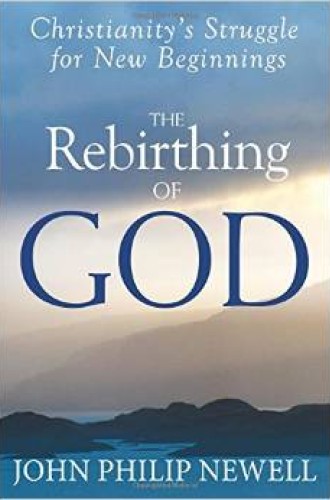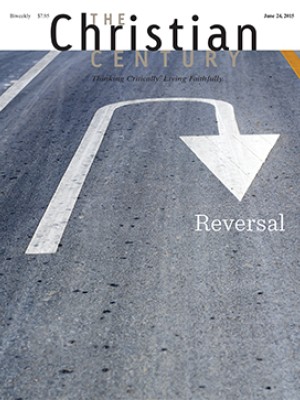The Rebirthing of God, by John Philip Newell
Christianity in the West is undergoing a “seismic collapse,” author John Philip Newell declares in The Rebirthing of God. Only “a radical reemergence of the Divine” can save it. We must “rebirth God” in the world.
The language is dramatic (and the theology of the image is dubious—more on that in a bit). However, the ways in which Newell suggests that this “rebirthing of soul-force” could happen are hardly sensational. Creation spirituality, social justice, contemplative prayer, interreligious dialogue, and nonviolence are all directions to which many voices have been urging us for decades.
The Rebirthing of God is structured as an imagined pilgrimage walk around the Isle of Iona, where Newell was formerly the warden of the abbey. Each chapter is linked with a particular place on the island’s map: the ruins of the 13th-century nunnery, open to the sky, remind us of our connection to the earth, for example; the tenth-century standing stone cross of St. Martin in front of the abbey invites us to remember the primacy of love.
Read our latest issue or browse back issues.
Newell quotes from many wise and venerable sources: Julian of Norwich, Pierre Teilhard de Chardin, Thomas Merton, Simone Weil. He relies heavily as well on Gandhi, Carl Jung, the poetry of Mary Oliver, and remembrances of George MacLeod of Iona. And he refers extensively to his own experience and writing; many of the stories and illustrations here will be familiar to readers of his previous work.
Newell’s style is rambling, anecdotal, personal—as is fitting, perhaps, for a pilgrimage on a holy island. But an island is isolated. Newell does not seem to have engaged or connected with Christian writers currently at work in this vineyard. N. T. Wright is doing strong, creative biblical exegesis that reframes and makes new the hope that is in us. Sarah Coakley is redigging the fields of systematic theology. And Francis Spufford is reframing Christian apologetics for the rising generation.
What Newell offers in this book is not an original remedy for or even definition of the “collapse” of Christianity. Rather, it is a conventional admonition to strengthen our inner lives by reconnecting with nature, remembering our dreams, and practicing contemplative prayer.
Despite the initial announcement of the imminent demise of Christianity and the urgent need for “the rebirth of the Sacred,” the book is oddly passionless and unfocused. Newell doesn’t really seem to care much about Christianity. Little in these pages indicates awareness or exploration of current problems facing the church at any level. On the other hand, Newell seems greatly concerned to suggest only remedies that would be inoffensive to Jewish, Buddhist, Hindu, or even spiritual-but-not-religious New Age readers.
The attempt to be inclusive renders the solutions anodyne—of the least-common-denominator variety rather than anything reflective of distinctively Christian theology or practice. References to Jesus are thin on the ground, and New Testament citations are few; when Newell does use them, he almost always dilutes them or generalizes them into oblivion. For instance, “the story of the incarnate Christ” is not a scandalous particularity, the deepest of sacred mysteries. Instead, it merely “points to the oneness of . . . spirit and matter,” revealing “the sacredness of every person.”
A clue to Newell’s reluctance to use language that is unequivocally Christian is his repeated use of the title image of “rebirthing God.” As the death and resurrection of Jesus are indispensable to Christian theology and differentiate Christianity from other religions, Newell seems to have found it easier to avoid dying-and-rising language and instead to speak in vaguely animist or Hindu terms of rebirth.
Jesus’ only mention of anything like rebirth in the Gospel record is the need for us—not God—to be “born anew” if we would enter the kingdom of God (John 3:5). The apostle Paul famously uses the metaphor of childbirth, labor, and delivery—“all creation groaning in travail” in the birth throes of the promised new creation brought about by the resurrection (Rom. 8:22)—but it is God’s creation that is being reborn, not the Creator.
Pronouncing a human imperative to “rebirth God” without careful grounding in scripture or complex mystical theology is tricky. It is certainly presumptuous, and it risks attenuating the mystery of the incarnation into something close to divine reincarnation.
For nonbelievers, “seekers,” and adherents of other faiths, The Rebirthing of God might be an introduction to Christianity at its mildest and least challenging. As a map of Newell’s own journey, the book will be of interest to his many admirers. As an exploration of the ways in which the institutional church has missed the mark and might find a way into the future, it offers little to instruct or guide the rest of us.







